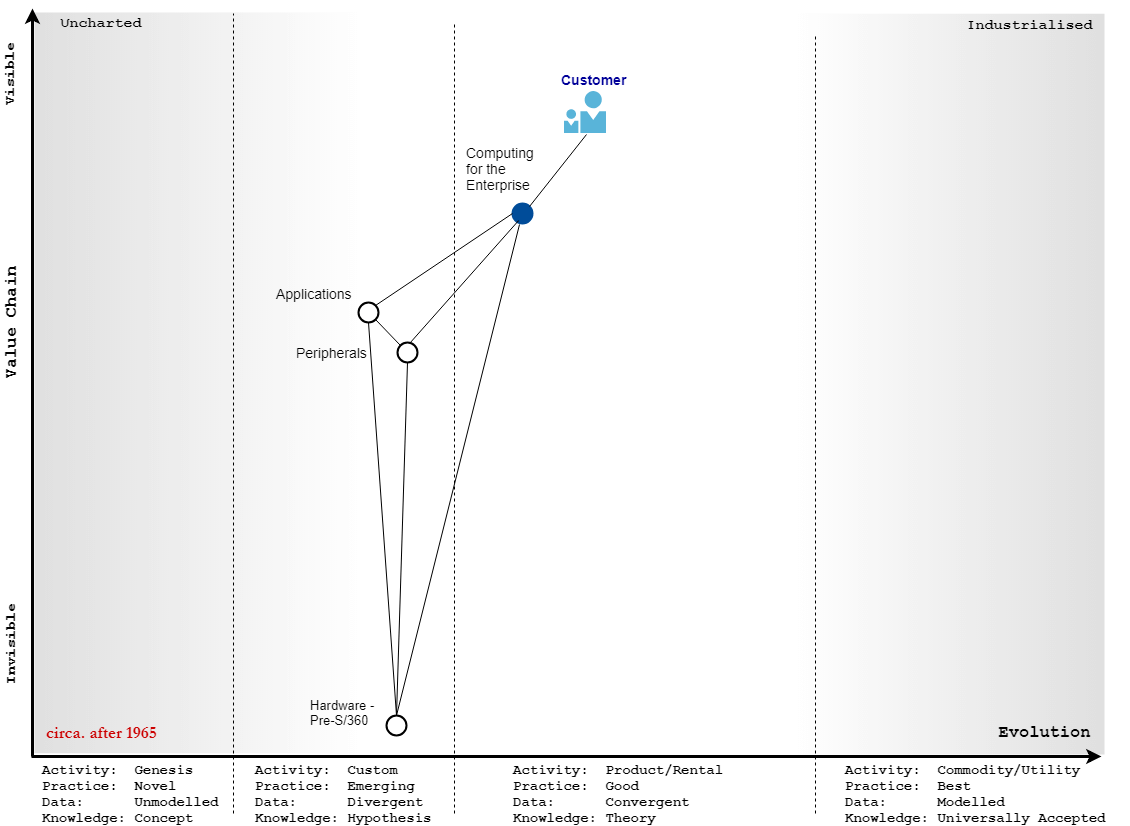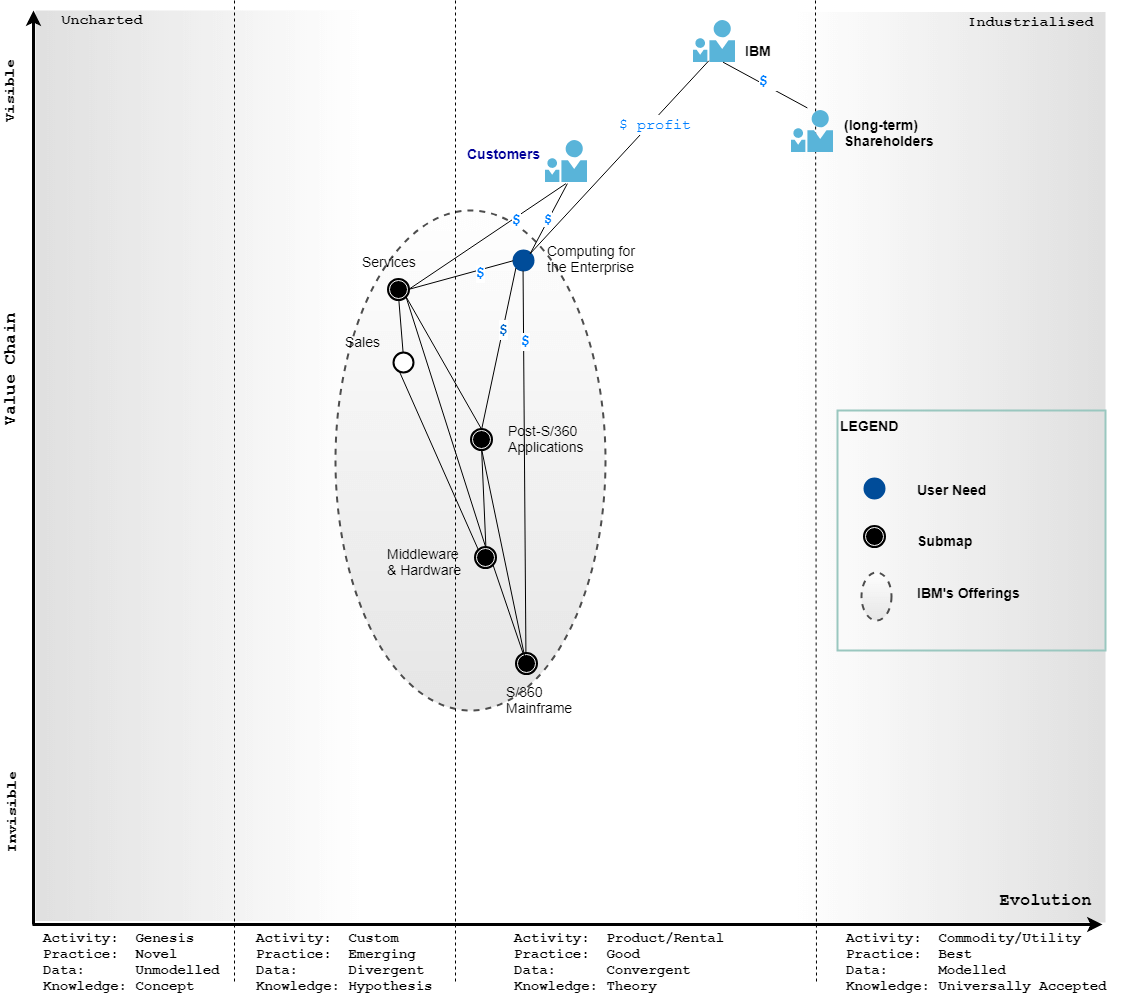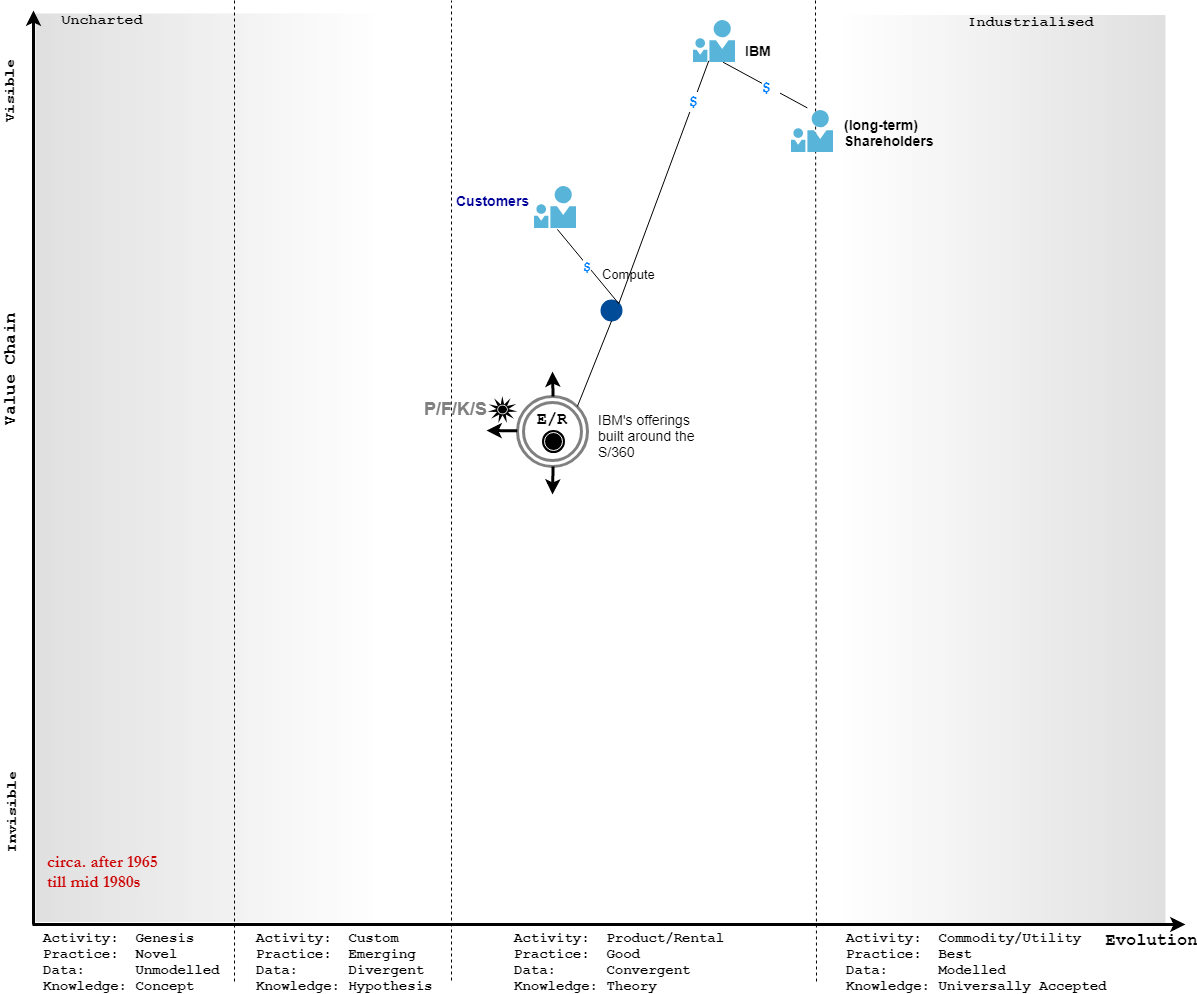Wardley Maps—an Illustration from Gerstner’s book —Part 2
The second loop around the Strategy Cycle is in chapters 8-10 of Lou Gerstner’s book, “Who Says Elephants can’t Dance,” in which he summarises his plan in the following sentence:
“I turned my attention to three areas that, if not fundamentally changed, would disable any hope of a strategy built around integration: organization, brand image, and compensation.”
Gerstner Jr., Louis V. (p. 83).
I’ve found that to map out the above quote (probably for another blog post), I needed to understand IBM’s history a little, its success with its subsequent effects on IBM’s market position and on IBM itself, and lastly, the factors that led to Gerstner’s changes being not only necessary, but as “stones” (if I may borrow from Simon Wardley’s talk titles) that he (Gerstner) needed in “Crossing the River by feeling the stones” as he looped around the Strategy Cycle several times.
I asked myself several times why I had to know this or why I felt it important. After all, it’s ended up being long enough that I’ve had to separate it out into its own post. Well, it dawned on me that knowing about it would form the “Landscape” that Gerstner would be considering. And “Landscape” is (if I can insert a reminder here) the second important part of the Strategy Cycle. Afterwards comes “Climate,” “Doctrine,” “Leadership.”
A disclaimer applies: these maps are are my interpretations, which might be right, or wrong, or in between, but nonetheless useful.
So Caveat Emptor ¯\_(ツ)_/¯
Digressions – slightly useful to some
First, I often recommend (when asked) to practice mapping from articles (example) , books, tweets (example), talks, even “vision” or “future” statements from organisations (example).
In addition to these being in a more evolved state of Evolution (Cognitive Hierarchy post), they already contain the material that we need to “only” express. I apply Alexander Bain‘s principle of learning composition in writing to Wardley Mapping (see square brackets):
The Composition of Themes involves the burden of finding matter as well as language; . . . For an English [mapping] exercise, the matter should in some way or other be supplied, and the pupil disciplined in giving it expression [mapping it out]. . . Another exercise is the conversion of Poetry into Prose [from maps, create “stories”] [and vice-versa – from “stories,” create maps].
Alexander Bain’s “English Composition and Rhetoric”. Page vii in the Preface.
Through this, we build this up as a habit, which is manifested when we have to map but are constrained regarding time. Speaking of forming habits, A. B. Simpson writes:
Every habit grows out of a succession of little acts. No habit comes full-grown into your life; it grows like the roots of a tree. . .The stenographer takes down words as fast as they are spoken. At first it is clumsy and slow work; but at length it becomes a habit, and now the stenographer does not have to stop and think how to make the characters; they come as naturally as words come to the lips.
Simpson, A. B.. “The Christ Life.” Location 517. Kindle Edition.
Wouldn’t it be great if mapping with its symbols, stages of evolution and their characteristics, the sources of capital, doctrine, climatic patterns, gameplay would come naturally to us as words come to lips. The downside is what Ian Walker coined as the “Wardley Curse” 😂
Secondly is how long it should take to do these maps. That also depends on your context/situation. Sometimes we use “maps” as a term to mean the Value Vhain + Evolution, which represents only in the “Landscape” part of the Strategy Cycle. Other time we use the same term to mean the entire Strategy Cycle.
Even if we limited the term to mean the Value Chain + Evolution, the time it would take to draw a map of a tweet is likely to be smaller than that of multinational organisation or a nation state.
Ideally, the time required would be proportional to the scope and goal in mind.
Building on previous post
Before I continue, I’d like to point out one missing pieces from the previous post – pieces that I only found out through Holger and the attendees of the Wardley Mapping Meetup in Köln (aka Cologne).
Dealing with Inertia
Some maps of the previous post contain inertia barriers but I didn’t go into how he dealt with them. The “Messaging” component helped overcome some inertia, but to my mind, the biggest help to overcome came from the “Moral Imperative” and the emergency context. Because IBM was seen as a national treasure that had to be rescued, many employees willingly gave up their jobs, others volunteered to come out of their retirement to help, still others worked much harder. One gets a glimpse of this not only through the “Dedication” page, but also from sentences sprinkled throughout the book.
Maps that are bridges on what’s to come
To recap the previous article, as the underlying components are becoming more certain, Gerstner prepares to make another loop around the Strategy Cycle – shown in the map below: that the new “purpose,” “scope,” and “moral imperative” build on the corresponding components. The maps in this section link the previous article with what’s to come, to the next loop around the Strategy Cycle.
 Wardley Map summarising previous articles in the series
Wardley Map summarising previous articles in the series
The map below is for completeness only. After the explanation is the next two sentences, I’ll dispense with the horizontal dotted arrow lines.
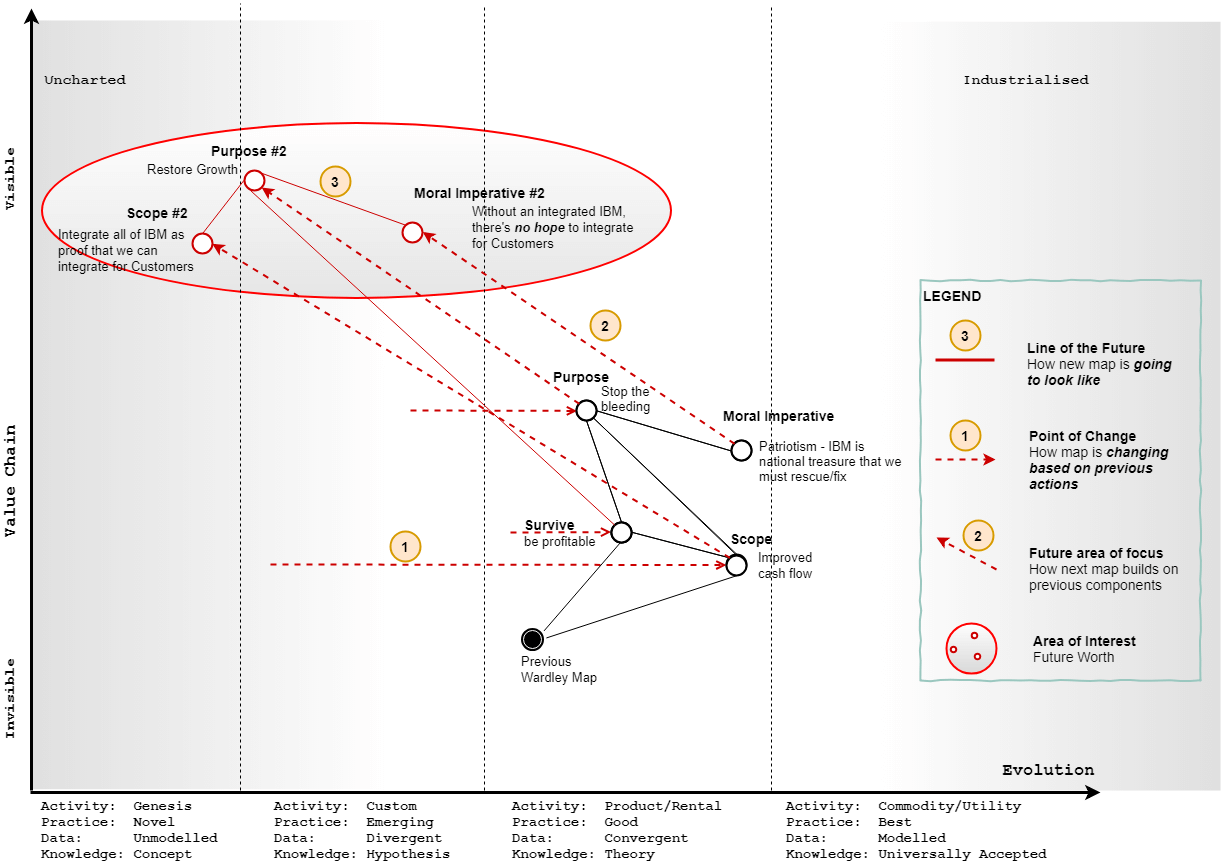 Build on previous map to prepare for what to do next
Build on previous map to prepare for what to do next
Now, because the new map (#3) is built upon (#2) underlying components that are still evolving (remember that these initiatives took about 8 to 10 years), I’m using the dotted red arrow (#1) in the map to represent this.
Naturally it makes the map appear a bit cluttered.
Removing the previous components simplifies the map below – see below – and adds the knowledge and practices that Gerstner obtained from his previous experiences at McKinsey.
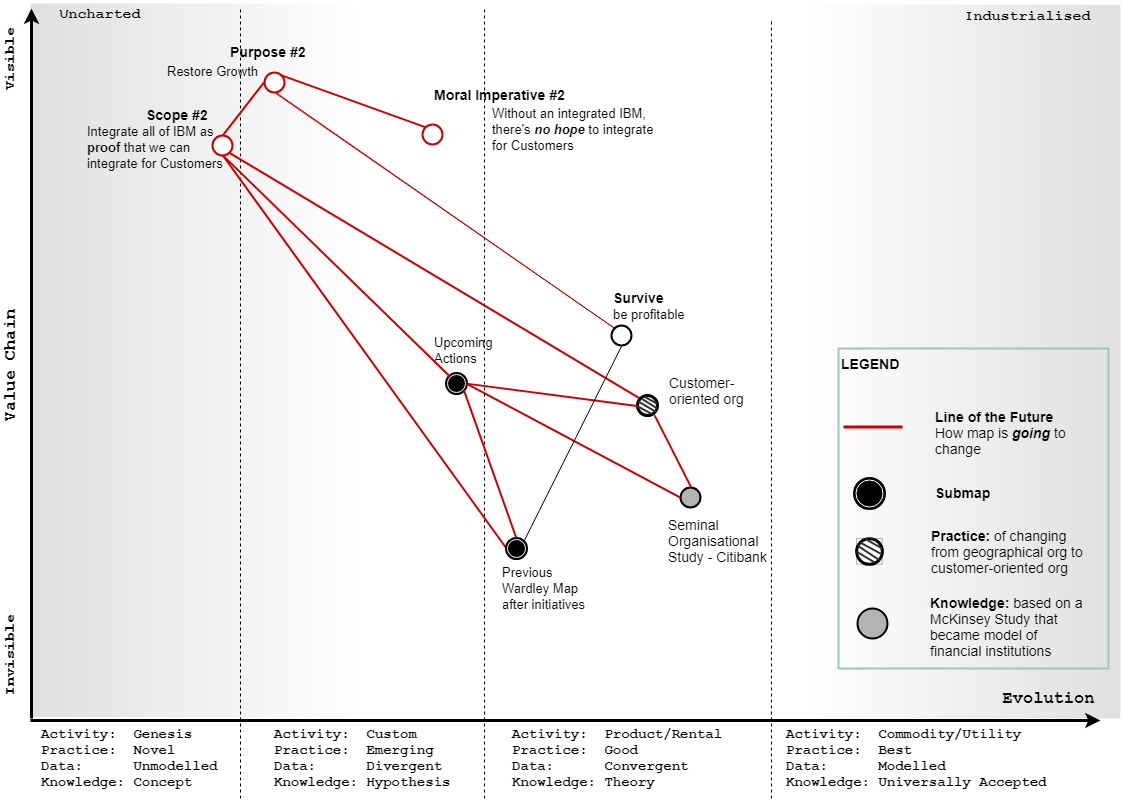 Previous maps abstracted as submaps
Previous maps abstracted as submaps
Background to Gerstner’s second loop – the S/360
Besides what Gerstner had done “to stop the bleeding,” making other loops required knowing what was essential at IBM. He tells us:
Despite the fact that IBM, then and now [circa. 1993], was regarded as a complex company with thousands of products, I’d argue that, until the mid-1980s, IBM was a one-product company—a mainframe company—with an array of multibillion-dollar businesses attached to that single franchise.
Gerstner Jr., Louis V. (pp. 116-117)
Which is why I followed along, and hope that you will too.
S/360 – its Background
What follows is an attempt to show this on Wardley Maps while taking account of the historical background, which chapter 12 furnishes us with. I’ll also take selected paragraphs from Wikipedia to help with these maps.
The map shows what I imagine to be the Pre-S/360 phase – most components at in the “Custom” phase. Gerstner writes:
Before System/360, IBM was just one of several companies that made and sold computers. Each company’s computers were based on proprietary technology. They didn’t work with any other computers, even from the same company, and each computer system had its own peripheral devices like printers and tape drives. This meant that if customers outgrew a computer or wanted the advantages of some new technology, they had to discard all of their hardware and software investments and start over
Gerstner Jr., Louis V. (pp. 115)
I interpreted that to mean that most components are going to be in the “Custom” phase of evolution.
From the article in Wikipedia, the S/360 hardware was made from integrated circuits.
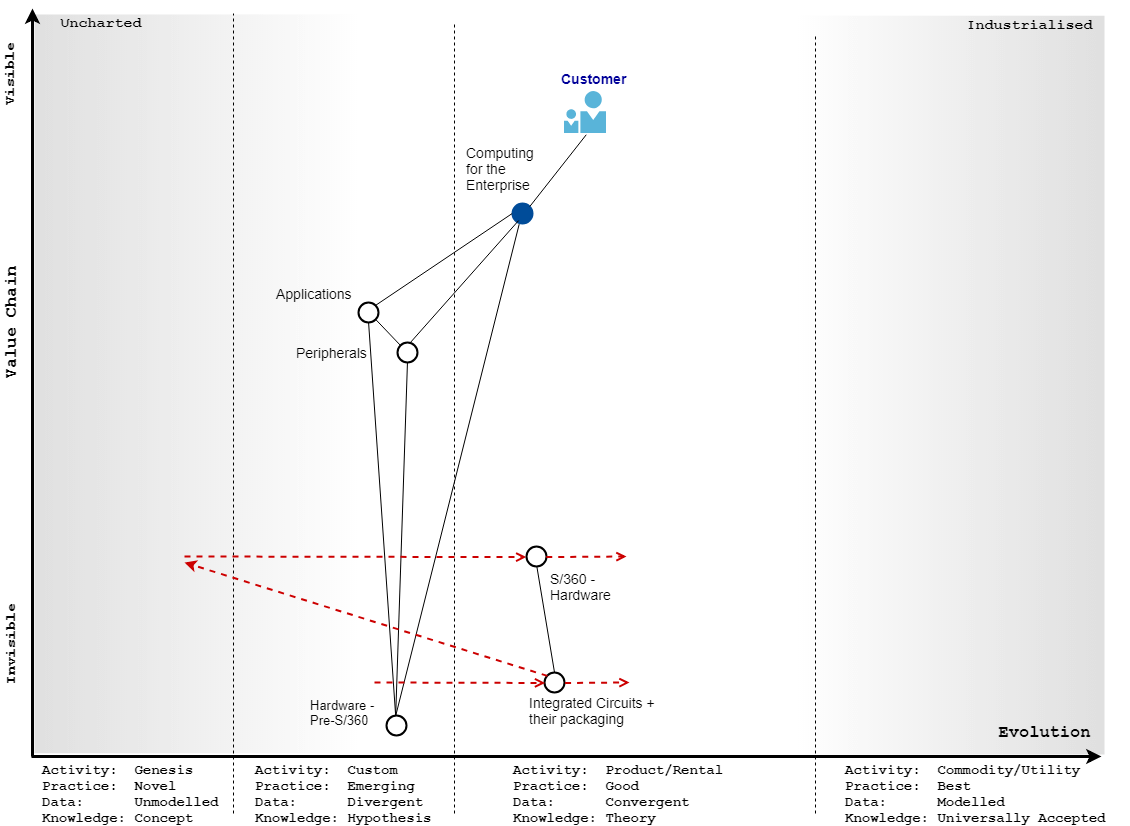 Evolving components that make up the S/360
Evolving components that make up the S/360
The next three maps show components that were being built ontop of S/360. First was the Operating System, then Middleware.
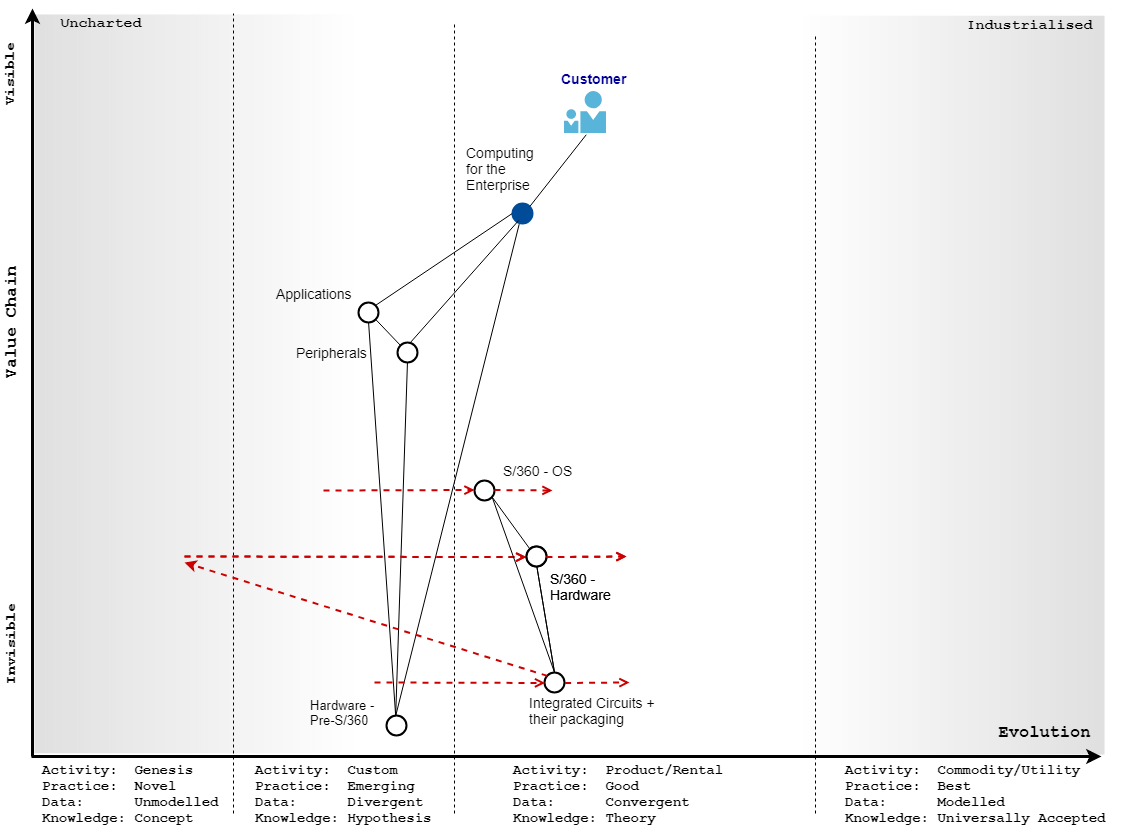 Operating System S/360 is also evolving
Operating System S/360 is also evolving
Then the Middleware technologies are listed below.
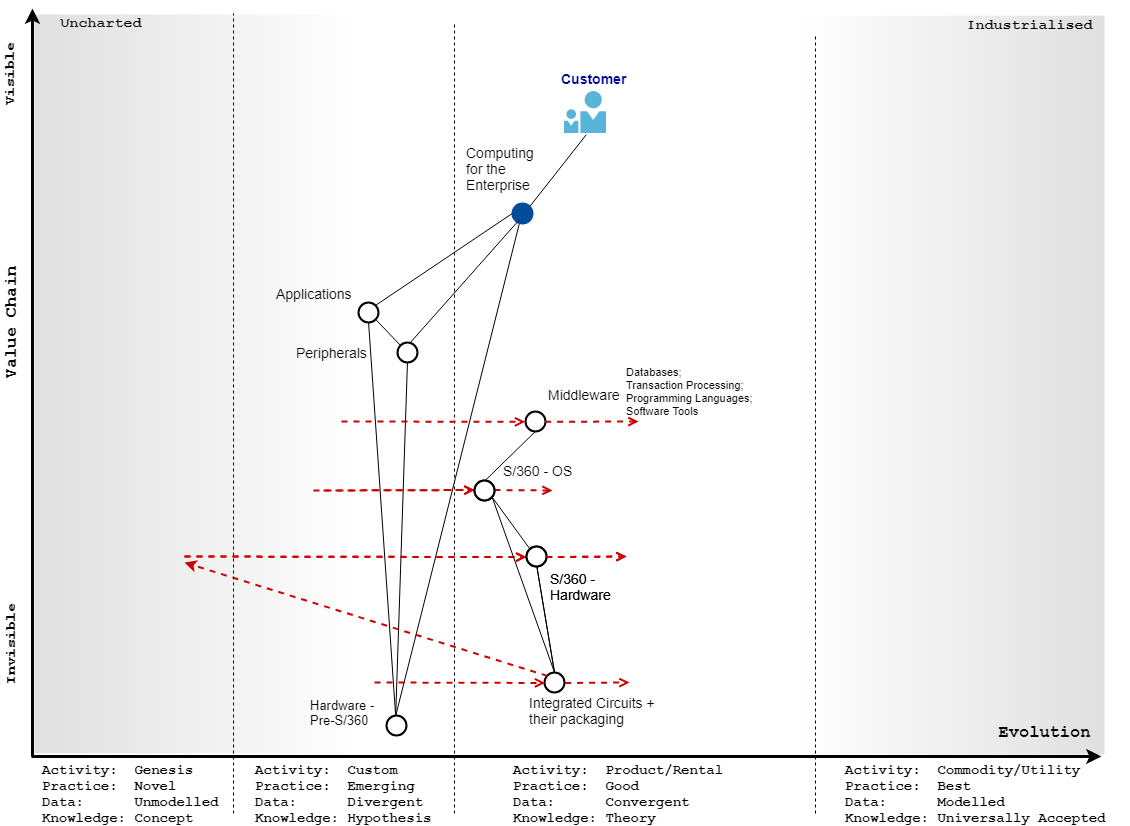 Middleware technologies build on the evolved components of the S/360
Middleware technologies build on the evolved components of the S/360
Applications and Peripherals are now (circa. After 1965) being built on top of the new S/360.
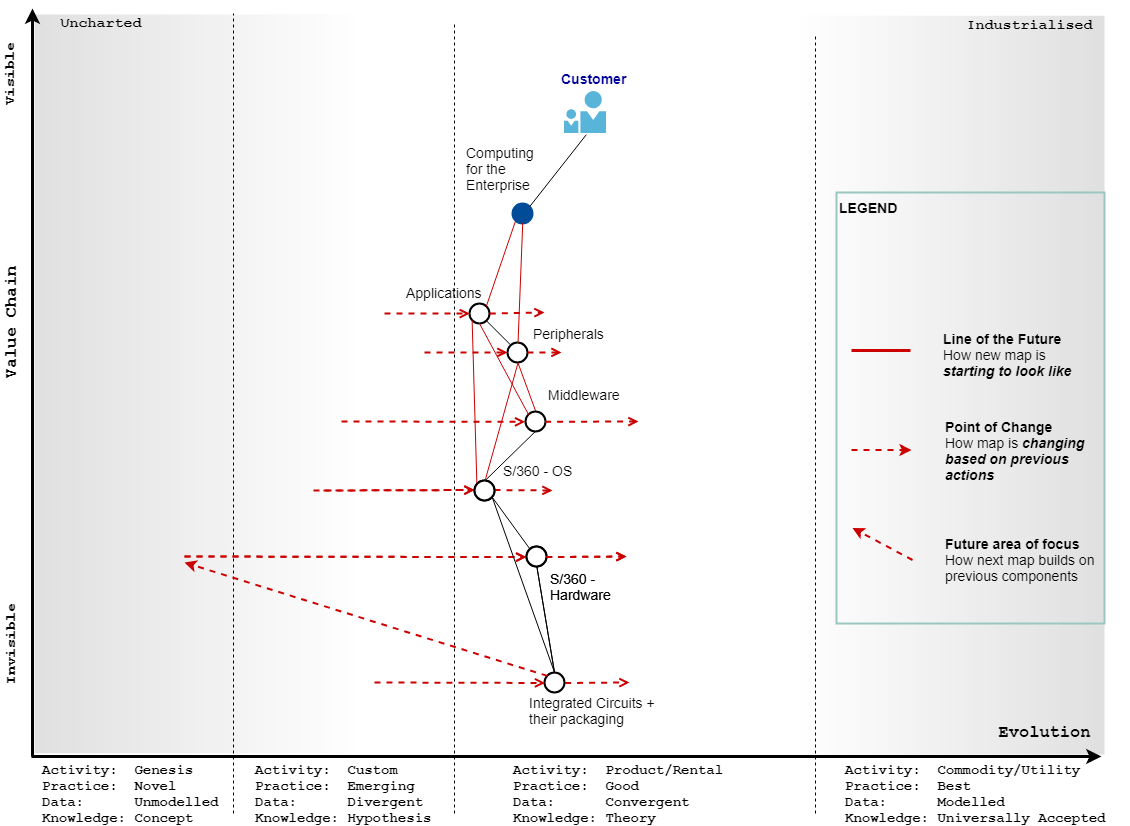 Applications and Peripherals are now (circa. After 1965) being built on top of the new S/360
Applications and Peripherals are now (circa. After 1965) being built on top of the new S/360
The components “Application” and “Peripherals” are being built on top of what the S/360 made possible. Gerstner continues,
Software developed for one processor would run on any System/360 processor. All peripheral devices—printers, tape drives, punch-card readers—would work with any processor in the family. For customers, System/360 would be a godsend. For IBM’s competitors, it would be a knockout blow
Gerstner Jr., Louis V. (pp. 115)
I’ll come back to the competition later.
What’s noteworthy in the map below is the dying out of the previous Value Chain (shown in Gray) and the creation of new value chains that became the base for IBM’s dominance for two to three decades (circa. 1965 – 1985).
 The dying out of the previous Value Chain (shown in Gray) and the creation of new value chains that became the base for IBM’s dominance for two to three decades (circa. 1965 - 1985)
The dying out of the previous Value Chain (shown in Gray) and the creation of new value chains that became the base for IBM’s dominance for two to three decades (circa. 1965 - 1985)
Because of the new S/360, there was the building up of new capabilities and the Co-evolution of Practices, such as the Sales force having to change. Gerstner reminds us:
System/360 required a very knowledgeable, consultative sales force that could help customers transform important business processes like accounting, payroll, and inventory management. Traditional order takers couldn’t do this job.
Gerstner Jr., Louis V. (p. 116)
To show this, I’ll make the S/360 into a submap.
 Circling components of the S/360 that are to be made into a submap
Circling components of the S/360 that are to be made into a submap
Giving us
 The S/360 Wardley Map abstracted away into a submap
The S/360 Wardley Map abstracted away into a submap
Then the new areas of growth (circa. after 1965) are occurring. Details of the 3 new Submaps (Services, Post-S/360 Applications, and Middleware) are on Page 154 of the book.
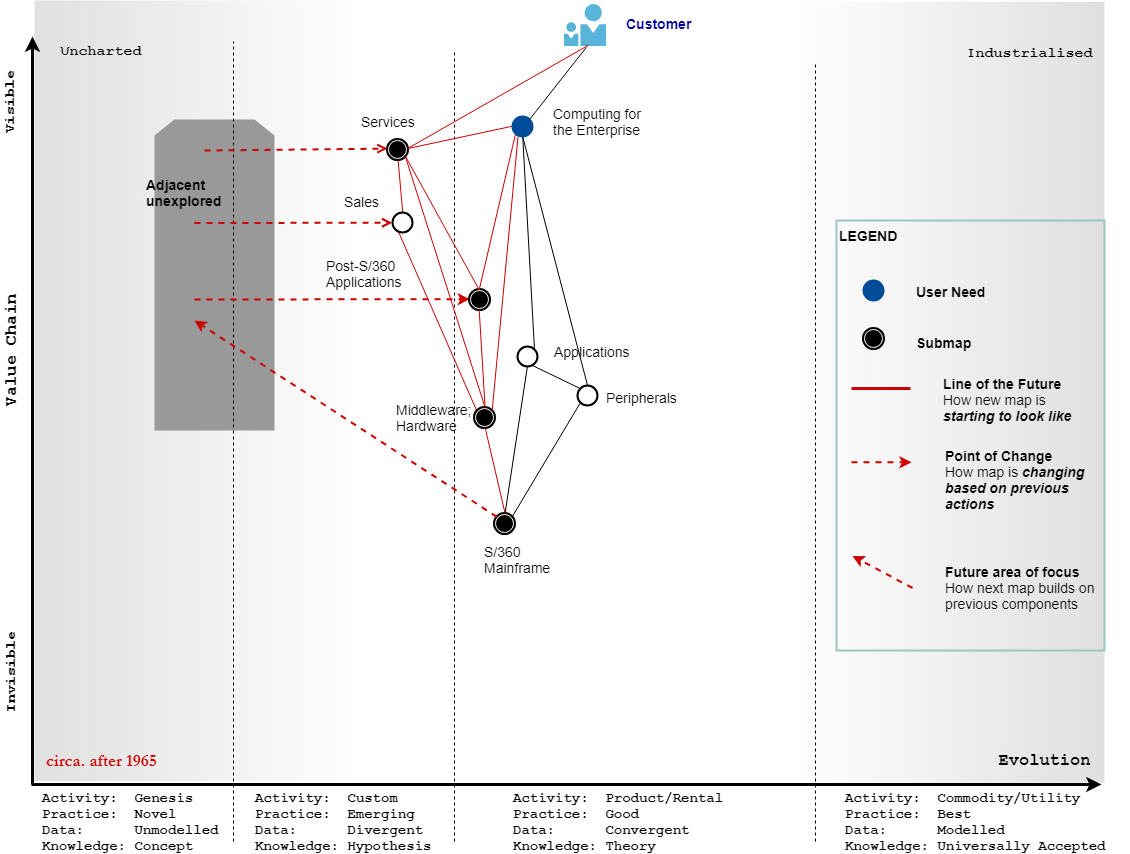 New components springing up to create interoperable applications on the S/360
New components springing up to create interoperable applications on the S/360
S/360 – its Success
Building on the S/360 led to IBM’s dominance. I’ve taken ideas from the pdf, “The Future is predictable” together with Simon Wardley’s posts. For this, I’ll add more Users to the Map, and also Porter’s 5 forces.
With tweaks (that are specific to IBM and enclosed in square brackets), these sentences from Simon Wardley’s post (after Figure 247 in Chapter 19) are applicable.
From the map, we start with the industry [IBM] itself. It has a need for investors (i.e. shareholders) which involves a bidirectional flow of capital e.g. investment from the shareholders and return on investment to the shareholders. I’ve simply marked this as a “$” to represent a financial flow in both directions. . . . In order to pay for the return on investment (whether dividends or share buybacks) [IBM] needs to do something that makes a profit. This involves [providing Computing] to Customers.
Simon Wardley; “Wadley Maps” on Medium, Chapter 19, Figure 247
Represent competition with Porter
To represent the competitive landscape, I’ll use Michael Porter’s 5 Forces.
Recap on Porter’s 5 Forces on a Wardley Map
Simon Wardley applies Porter’s 5 forces in Chapter 17 (section titled “On Porter” and Figure 222) onto a Map. The whole section is worth reading. I’ll quote the relevant parts here & also use the same figure:
For those unfamiliar with Porter’s five forces, these are rivalry within the industry, threats of new entrants, threats of substitution and the bargaining power of suppliers vs consumers. In this section we’re going to examine these five forces through the lens of the peace, war and wonder cycle (see chapter 9).
Simon Wardley; “Wadleymaps” series on Medium, Chapter 17
In the time of Wonder:
In the time of wonder, it is a battle to become established. The field is not yet developed and there are no “new entrants” as there are no established figures to be “new entrants” against. Everything is new, uncertain and uncharted. It is the wild west, ‘ere be dragons and the home of split infinitives. The consumers hold the power and it is they who decide whether this industry will succeed or not despite their initial inability to know whether they need it.
Simon Wardley; “Wadleymaps” series on Medium, Chapter 17
In the time of Peace:
In the time of peace, there is a constant tug of war between supplier and consumer power over the products produced. The developing giants are normally well protected from new entrants in a game of relative competition. The exception is the occasional threat of substitution. It is this substitution by a different product which tends to be the dominant factor.
Simon Wardley; “Wadleymaps” series on Medium, Chapter 17
In the time of War:
In the time of war, new entrants providing a more industrialised form of the act threaten the existing giants that are stuck behind inertia barriers. It becomes a fight for survival for these giants and they are often poorly equipped. It is not a case of a product becoming substituted by another product but instead an entire industry being changed to more industrialised forms. It is often assumed that the shift towards utility provision means centralisation but this is not the case.
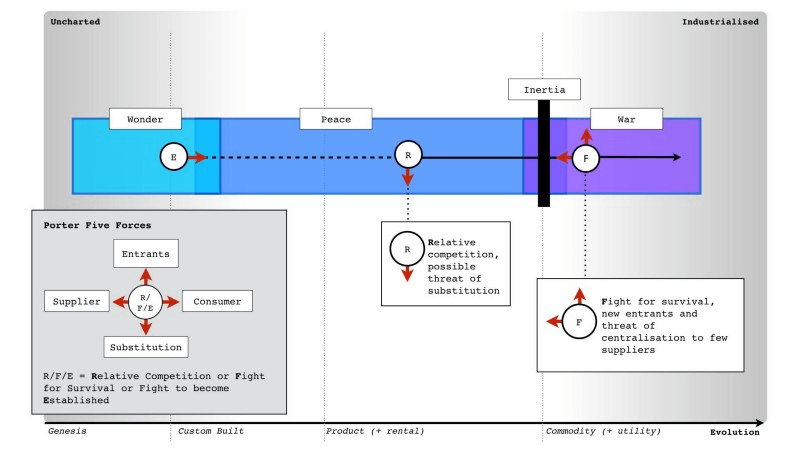 Michael Porter’s 5 forces are shown on a Wardley Map
Michael Porter’s 5 forces are shown on a Wardley Map
Since we’re talking about IBM during the period of 1960s to early 1990s, I don’t expect to have components in the time of “War.” You can read more about these forces from Simon Wardley, and the forces themselves are well explained by Porter himself (see HBR article from 1979).
S/360 – with Porter’s 5 Forces
Let’s apply Porter’s forces to our map. How would it look like ?
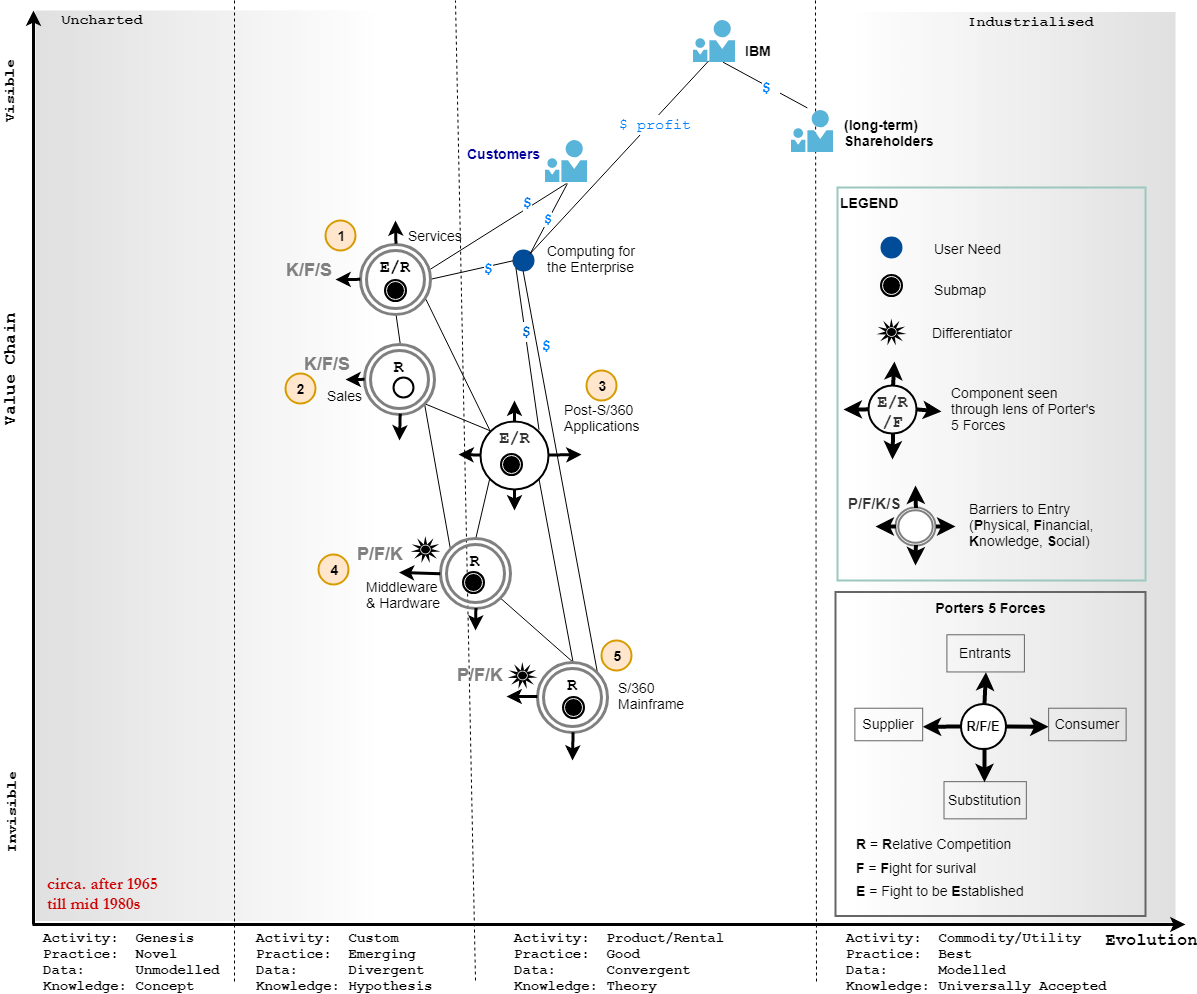 Porter’s 5 Forces are applied to the Wardley Map of the S/360
Porter’s 5 Forces are applied to the Wardley Map of the S/360
A few basic notes:
- Firstly, every double-circle represents a Barrier to Entry.
- Secondly, since the existing components were submaps, enclosing them within the symbols representing Porter’s forces was more convenient than attaching the forces to the components themselves.
- Finally, all these components have an arrow pointing left, meaning that the suppliers, in this case, IBM had a lot of bargaining power, which is characterised by Porter as:
the power of each important supplier … depends on a number of characteristics of its market situation and on the relative importance of its sales … to the industry compared with its overall business.
Michael Porter in https://hbr.org/1979/03/how-competitive-forces-shape-strategy
(1) and (2) The Services and Sales components can best be seen in Gerstner’s description:
Even the sales force had to change. System/360 required a very knowledgeable, consultative sales force that could help customers transform important business processes like accounting, payroll, and inventory management. Traditional order takers couldn’t do this job. The company had to create a product service and maintenance capability and a customer-training and educational arm
Gerstner Jr., Louis V. (p. 116)
Hence the reason I’m representing these barriers as K/F/S — i.e., “Knowledge” that the Sales forces requires; “Financial” barrier required to train up such a workforce and setup the Services capability; lastly “Social” because that’s the backbone of Sales and Services (in my optinion). On the other hand, since the “Services” component is “new,” it would be fighting to be established. My inference is that because it’s setup from the company that provides the underlying component, it’s perceived as more credible in the eyes of Customers.
(3) The component, “Post S/360 Application,” was important but not that high a barrier to entry. Because of which, suppliers could be substituted. This in turn increased the Customers’ bargaining power.
(4) and (5) were differentiators and therefore barriers too. Gerstner writes:
How did we end up in 1990 with the world’s largest software business? Because there would be no usable System/360 without an operating system, or a database, or a transaction processing system, or software tools and programming languages
Gerstner Jr., Louis V. (p. 116)
These crucial components (1), (2), (4), and (5) don’t have arrows pointing right, which means that the Customers’ bargaining power was limited. The S/360 and most of the components built on top of it were not undifferentiated to such an extent that Customers could always find alternative suppliers. Furthermore, Customers also loved what the S/360 made possible: more powerful, reliable, and less costly machines that allow for interoperable software applications. The result was that
IBM’s share of the computing market skyrocketed. Competitors reeled; many disappeared. The company’s revenues grew at a compound growth rate of 14 percent from 1965 to 1985. Gross profit margins were amazing—consistently around 60 percent. Market share exceeded an astounding 30 percent, which eventually invited antitrust scrutiny.
Gerstner Jr., Louis V. (p. 117)
More representations on our Wardley Maps
We’ll add more components to our maps.
Effects of Doctrine on Success and vice-versa
IBM’s leadership position in the marketplace, and even leading up to it, had created a a certain kind of culture/belief system/doctrine that was embodied by its visionary founder, Thomas J. Watson, Sr. Speaking of Watson, Gerstner writes:
Watson’s experience as a self-made man engendered a culture of respect, hard work, and ethical behavior. IBM was the leader in diversity for decades, well before governments even spoke of the need to seek equality in employment, advancement, and compensation. A sense of integrity, of responsibility, flows through the veins of IBM in a way I’ve never seen in any other company. IBM people are committed—committed to their company, and committed to what their company does. . . He [Watson, Sr.] summarized them in what he termed the Basic Beliefs: Excellence in everything we do. Superior customer service. Respect for the individual.
Gerstner Jr., Louis V. (pp 183-184)
Gerstner remarkably adds:
Institutionalizing these beliefs wasn’t just a matter of displaying signs in every office (although they were everywhere). The Beliefs were reflected in the compensation and benefits systems, in the management schools, in employee educational and training programs, in marketing, and in customer support. It was the doctrine of the company—and very few companies have extended a doctrine so pervasively
Gerstner Jr., Louis V. (p. 184)
These quotes are from Part 3 of the book (from chapter 20 to 23). Attempting to map out how he dealt with culture (as defined, and used, by Gerstner) is out of scope for these series that I’m doing. Those interested can read those enlightening chapters.
Adding these to the map would look like below: the first map shows what’s to be made into a submap:
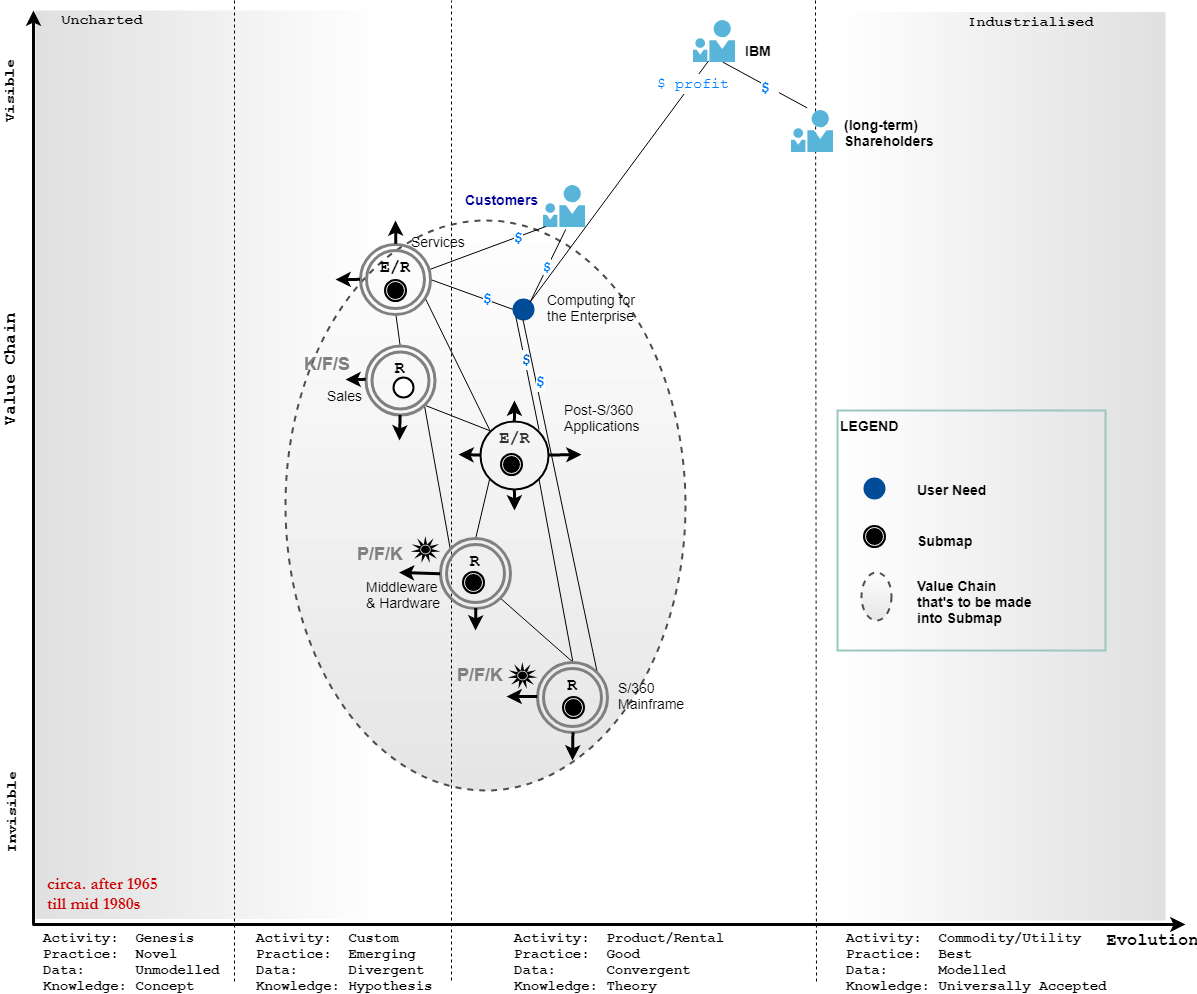 Components that are to be encapsulated into submaps
Components that are to be encapsulated into submaps
After making the value chain into a submap, we can add more components that build on it.
Position in the marketplace the basis of Compensation
Building on the submap, we see that the market for computing is growing, and IBM has the largest chunk (1), thanks for its offerings (number #2). These are made possible through the employees (number #3) who are compensated (point #4) according to some compensation model. Because being compensated for your work/labour is universally accepted, it’s in the Stage 4 of Evolution.
 Map with Employees and Compensation
Map with Employees and Compensation
As for the map below, it highlights components that affect Doctrine, i.e., the company’s position in the marketplace and its employees.
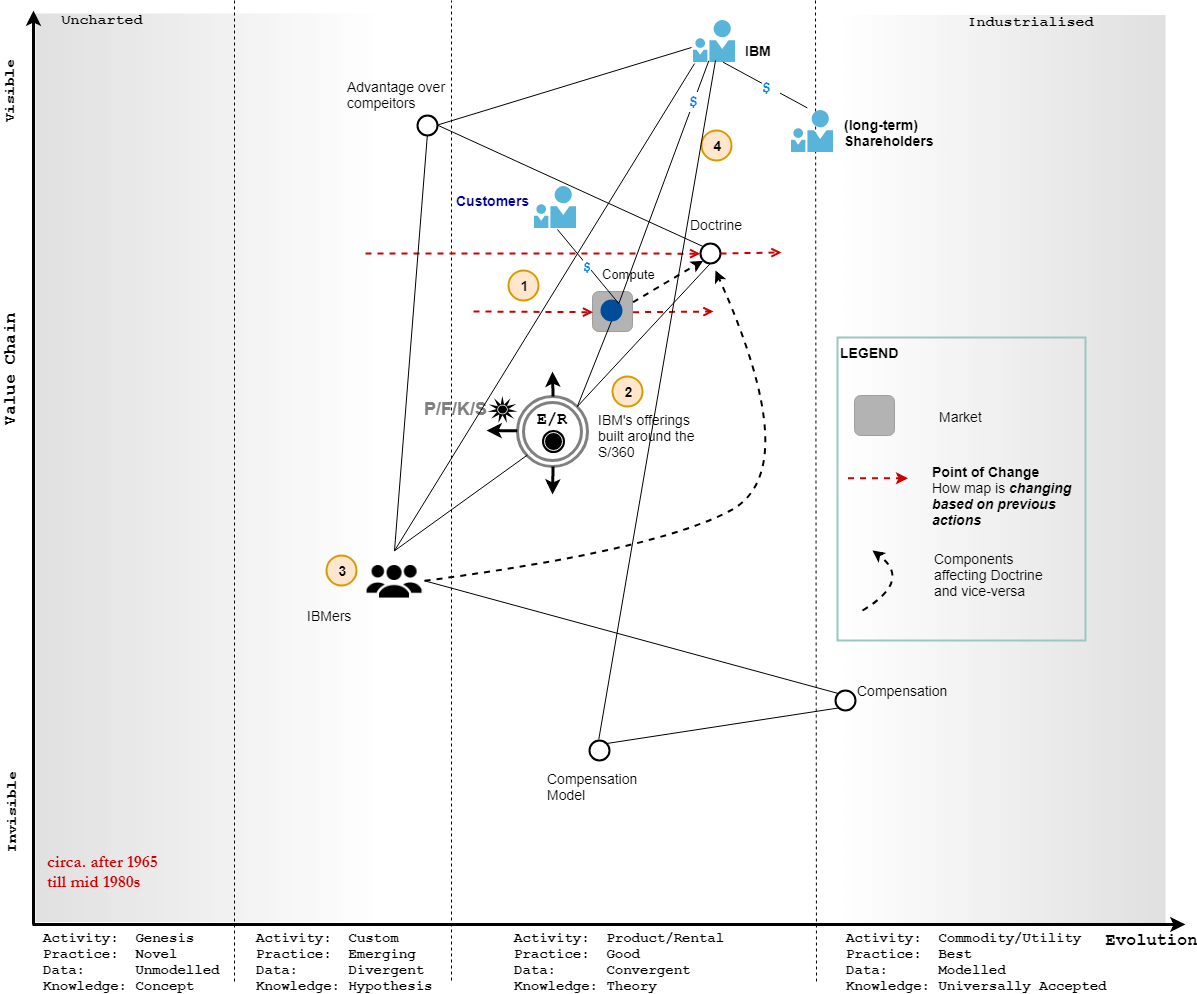 Components that affect Doctrine
Components that affect Doctrine
Which gives us the table below:
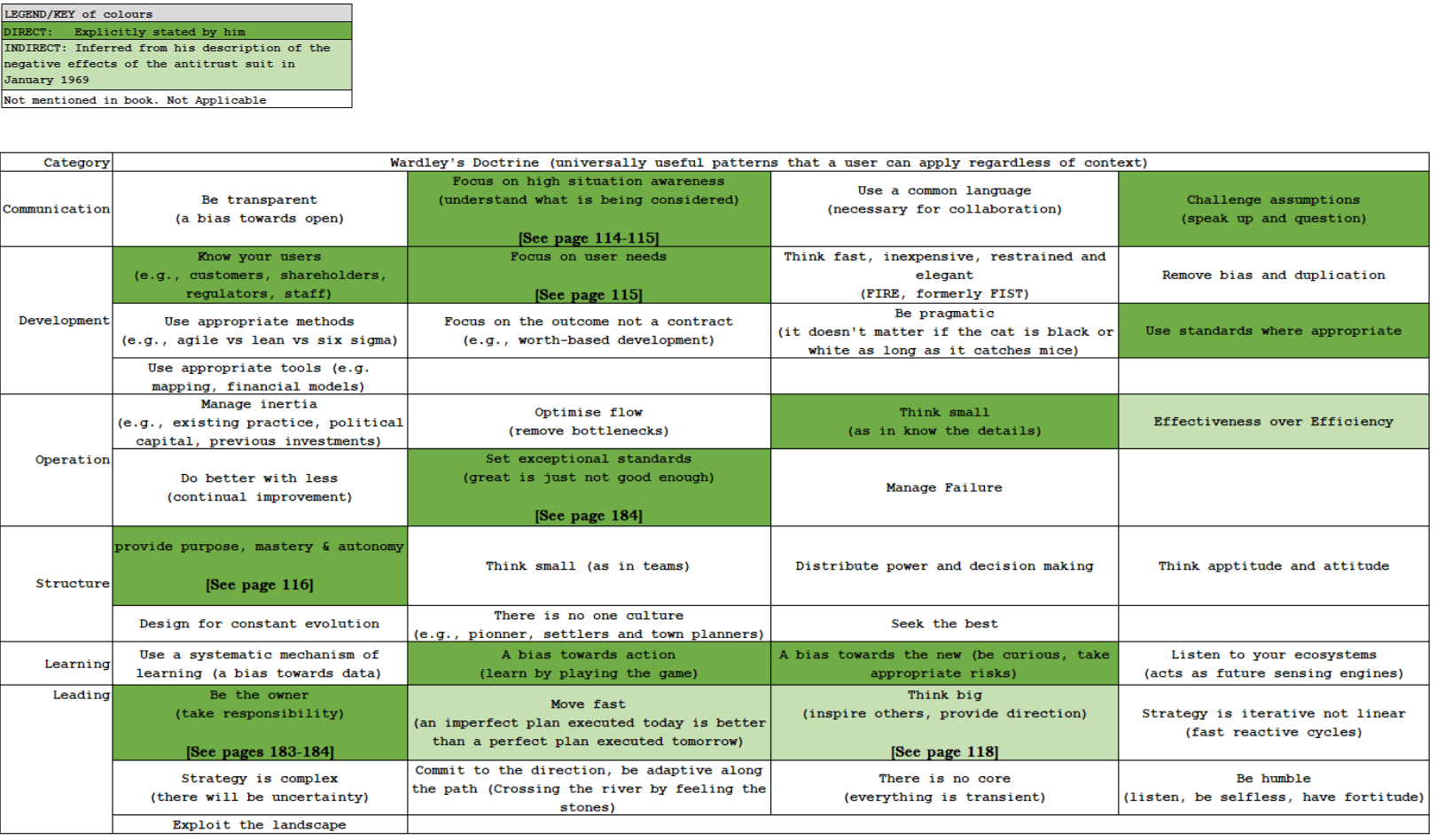 What Doctrine looked like at the time (circa. 1965 to the Mid 1980s)
What Doctrine looked like at the time (circa. 1965 to the Mid 1980s)
Factors leading to an org structure
Because of its position in the marketplace, IBM ended up serving many types of Customers. As it served more customers, so did it increased its marketshare.
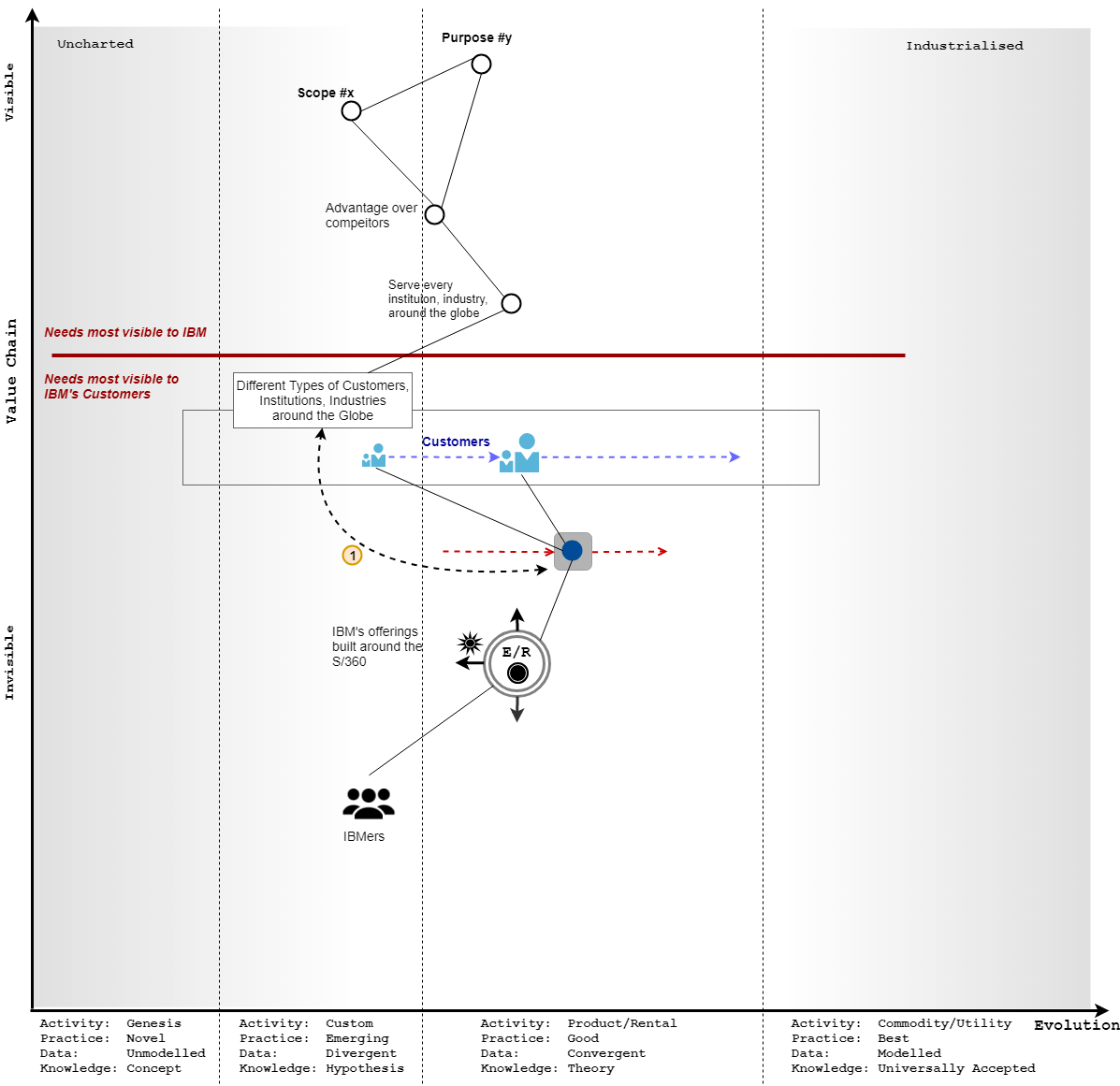 As IBM served more customers, it also increased its marketshare
As IBM served more customers, it also increased its marketshare
The map below adds another factor that led to the “Product Divisions” – which was to cope with the rate of technological change and the corresponding threats and opportunities.
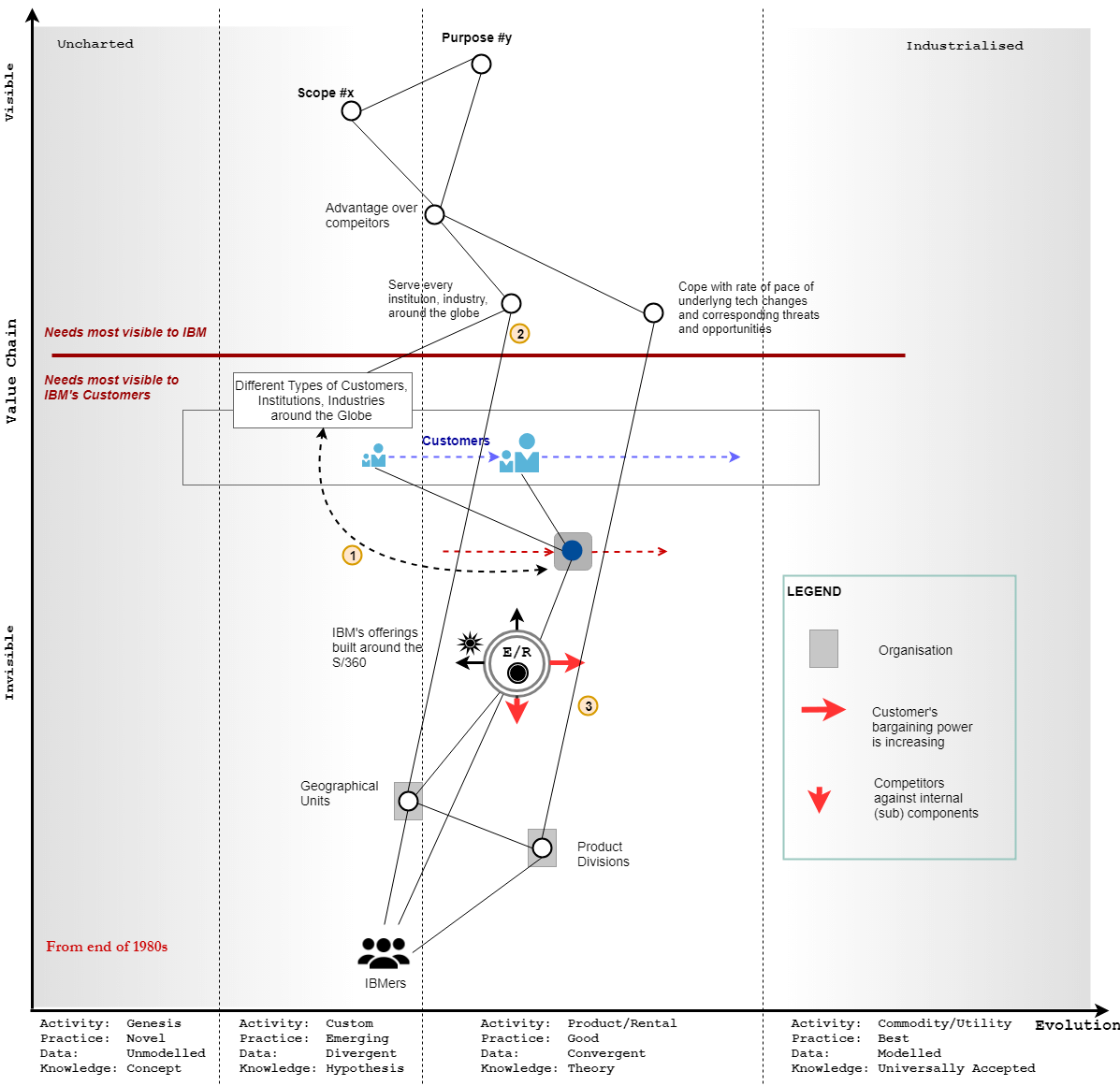 What led to the creation of Geographical Units and Product Divisions
What led to the creation of Geographical Units and Product Divisions
Conclusion
Like I said at the beginning of this post, I didn’t expect the background to be this long. Morever, there are a few things I’d wanted to add but I’m restricted by time and probably your attention 😉 – things such as the effect on Doctrine that came from being in such a dominant market position for decades; or the effect on Doctrine that crept in through the antitust suit that lasted for abou 13 years; or the partial blindness to the competition; etc.
For those interested in Culture, I’d recommend his observations in chapters 20 to 22, on its establishment, how it degrades, how it can be changed, and the sheer difficulty of maintaining it. Then compare his approach with those from today’s well-known companies.
As for those interested in Strategy, I’d recommend chapters 23 to 25 where he discusses what Strategy is not (e.g. vision statements), what it is, and it’s importance.
Ofcourse, I never would’ve been able to make any sense of it without Wardley Maps – both the work and the people. There’s always more to learn, and I’m looking forward to it. Notwithstanding, we have a decent base.
As for writing these posts, my current bottleneck is drawing these map. But Sertillanges’ remark keeps nudging me on:
The reward of a work is to have produced it; the reward of effort is to have grown by it.
Antonin Sertillanges, “The Intellectual Life”
